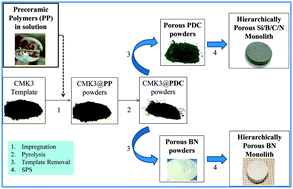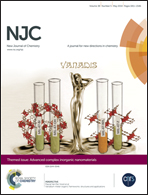Ordered mesoporous polymer-derived ceramics and their processing into hierarchically porous boron nitride and silicoboron carbonitride monoliths†
Abstract
Inorganic porous materials are widely used in a number of applications, where there is a need to produce materials with a controlled and/or multiscale porosity. In this category, periodic mesoporous boron- and silicon-based non-oxide ceramic frameworks with P6mm hexagonal symmetry attract increasing interest due to their unique properties, functionalities and potential applications. These materials are prepared by a hard-templating route (= nanocasting) using ordered mesoporous templates including silica (SBA-15) and carbon (CMK-3). In the first part of this perspective, the synthesis approach of ordered mesoporous boron nitride (BN) and silicoboron carbonitride (Si–B–C–N) is emphatically described including precursor selection and synthesis, nanocasting process, pyrolysis and template removal. In order to satisfy the requirement for practical applications, the second part of this perspective describes how a convenient powder processing approach that adopts the flexibility of powder-based processes (spark plasma sintering (SPS)) has been employed to produce without the use of any sintering additives mechanically stable, hierarchically porous BN and Si–B–C–N monoliths from ordered mesoporous powders.

- This article is part of the themed collection: Advanced Complex Inorganic Nanomaterials

 Please wait while we load your content...
Please wait while we load your content...